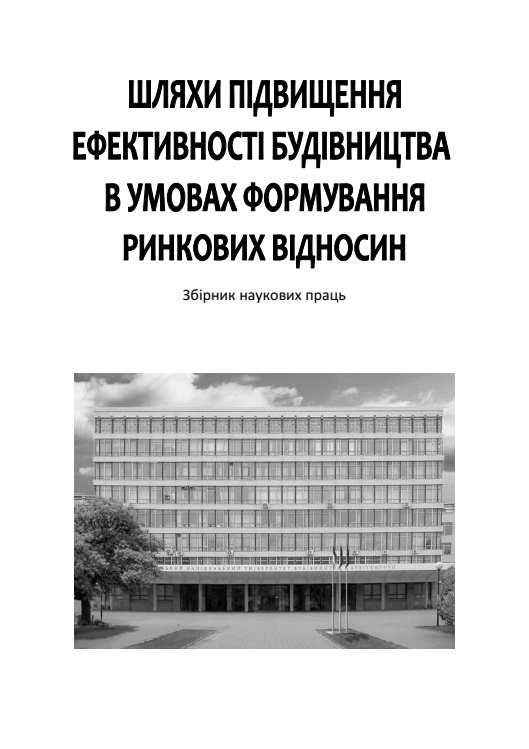Current assets for building enterprises and the specifics of managing them
DOI:
https://doi.org/10.32347/2707-501x.2018.38.161-170Keywords:
working capital, current assets, working capital construction organizations, management of working capital, sources of formation, sources of formation of working capital.Abstract
The article reveals the essence of the working capital of enterprises, the specific features for construction that determine the necessity of working out new approaches to solving specific problems of managing the working capital of the construction enterprises. The main factors that influence the total volume and structure of working capital of construction organizations are identified.
The basic principles underlying the determination of the optimal structure of working capital are considered and various variants of deviation from this theoretical optimal structure of working capital are presented.
The structure of working capital determines the financial condition of the enterprise, which in turn determines the competitiveness of the enterprise. The optimality of the structure of working capital is one of the most important conditions for ensuring innovative development of the enterprise, improving the ability of the company to create new products or modify old ones according to the modern needs of customers.
Current assets play an important role in the current economic environment as they form a significant and most mobile share in the assets of any entity. Therefore, when operating in a market economy as a business entity, any business must maintain its current assets at a level that responds quickly and efficiently to market needs.
The basic principles underlying the determination of optimal structure of working capital were considered and provide various options for variations from this theoretically optimal structure of working capital. Just consider the effect of such deviations on company activities.
Substantiates the main directions of researching optimal structure of working capital that would meet modern conditions of existence of domestic enterprises, as well as there are some practical approaches to determine the optimal structure of industry working capital, that are closed to modern conditions of domestic enterprises’ functioning.
The formation of complex balanced current assets management policy are discussed in this article. The theoretical approaches to the definition of "current assets", the basic measures, which require implementation during the formation of current assets management. It is alleged that the preservation improvement of the mechanism of management of working capital of the building enterprises on the growth of competitiveness of enterprises.
References
Гоцуляк С. М. Джерела фінансування оборотного капіталу / С. М. Гоцуляк //Вісн. нац. ун-ту «Львів. Політехніка». Менедж. та підприємництво в Україні: етапи становлення і пробл. розв. – 2010. – № 691. – С. 135‒140.
Ансофф И. Новая корпоративная стратегия: Пер. с англ. /И. Ансофф; общ. ред. Ю. Н. Каптуревского. – СПб.: Издательство «Питер», 1999. – 416 с.
Бригхем Ю. Ф. Энциклопедия финансового менеджмента /Ю.Ф. Бригхем. – М.: Экономика, 1998. – С. 823.
Колаcс Б. Управление финансовой деятельностью предприятия. Проблемы, концеп- ции, методы: пер. с француз. /общ. ред. Я. В. Воколова // Б. Колаcс. – М.: Финансы, ЮНИТИ, 1997. – 576 с.
Мездріков Ю.В. Аналіз джерел формування оборотного капіталу / Ю.В. Мездріков // Економічний аналіз: теорія і практика – 2007. – № 8. – С. 14–18.
Хохлов В. В. Оцінка ефективності використання фінансів підприємств в умовах ринкової економіки / В. В. Хохлов. – М.: Вища школа, 2006. – 212 с.
Кігель В. Р. Методи і моделі прийняття рішень в ринковій економіці: монографія / В. Р. Кігель. – К.: ЦУЛ, 2003. – 200 с.
Руденко А. В. Управління потоками капіталів у сучасній бізнес-моделі функціонування транснаціональних корпорацій: монографія / А. В. Руденко. – К.: Кондор, 2004. – 480 с.
Лахтіонова Л. А. Фінансовий аналіз об’єктів господарювання: монографія / Л. А. Лахтіонова. – К.: КНЕУ, 2011. – 387 с.
Рилєєв С.В. Роль політики управління оборотними активами в системі фінансового менеджменту підприємства /С.В. Рилєєв, С.М. Юрій // Науковий вісник Чернівецького торговельно-економічного інституту КНТЕУ. – Чернівці: Книги – ХХІ, 2009. – Вип. ІV. – С. 311‒319.
Добровольська О. В. Пріоритети формування оборотного капіталу підприємства у нестабільному середовищі / О. В. Добровольська // Інвестиції: практика та досвід – 2010. – №8 – С. 45–49.
Петрова Н.В. Формування оборотних коштів промислових підприємств: автореферат дисертації на здобуття наук. ступеня канд. екон. наук: спец. 08.00.04 «Економіка та управління підприємствами (за видами екон. діяльності)» / Н.В. Петрова. – ОДЕУ, 2007. – 18 с.
Бєлєнкова О.Ю. Управління оборотними активами будівельного підприємства як засіб отримання конкурентних переваг //О.Ю. Бєлєнкова/ Шляхи підвищення ефективності будівництва в умовах формування ринкових відносин.: зб. наукових праць. – вип.33. – 2015. – С.10- 17
Коренєва О.Г. Управління оборотними засобами підрядних будівельних організацій: Автореф. дис. канд. екон. наук: 08.04.01 - фінанси, грошовий обіг і кредит. - Українська академія банківської справи. -. Суми. – 1999. – 20 с.
Момот Т.В. Формування механізму управління оборотним капіталом підприємства (на прикладі підприємств будівельної галузі). – Автореф. дис. канд. екон. наук: 08.07.03 – “Економіка будівництва”. – Харківська державна академія міського господарства. – Харків. -1999.- 22 с.
Downloads
How to Cite
Issue
Section
License
Copyright (c) 2020 Yu. Zapiechna, L. Kovaleva, O. Chernoshtan

This work is licensed under a Creative Commons Attribution 4.0 International License.
Authors who publish with this journal agree to the following terms:
- Authors retain copyright and grant the journal right of first publication with the work simultaneously licensed under a Creative Commons Attribution License that allows others to share the work with an acknowledgement of the work's authorship and initial publication in this journal.
- Authors are able to enter into separate, additional contractual arrangements for the non-exclusive distribution of the journal's published version of the work (e.g., post it to an institutional repository or publish it in a book), with an acknowledgement of its initial publication in this journal.
- Authors are permitted and encouraged to post their work online (e.g., in institutional repositories or on their website) prior to and during the submission process, as it can lead to productive exchanges, as well as earlier and greater citation of published work (See The Effect of Open Access).

